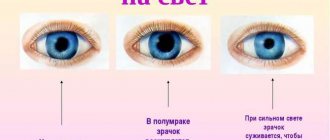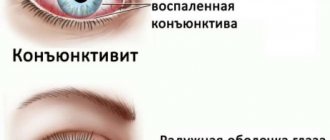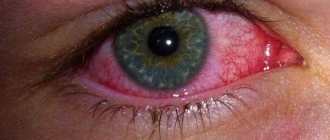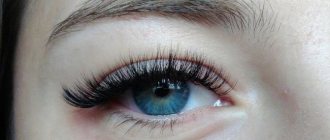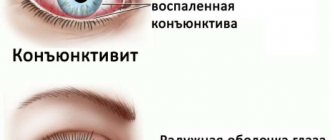Sometimes it happens that while having a conversation with a person, you notice that the interlocutor’s eyes are constantly “rolling.” It may seem that he is not at all interested in the topic of conversation. However, such human behavior can be explained by the development of a disease such as nystagmus. In Greek, the medical term is "slumber."
The pathology in question is a fairly common phenomenon. According to statistics, the disease often develops in children and is genetic in nature. Congenital pathology is detected in 20-40% of subjects. Most often, specialists are able to determine the etiology of involuntary movements of the eyeballs.
Causes
Symptoms
Diagnostics
Treatment
Causes
Eye movement pathology may have:
- innate character. Possible manifestation in infants aged a couple of months. It is extremely rare and is a consequence of a neurological disorder of a genetic nature;
- acquired character. It occurs when the deviation is a consequence of the development of related diseases.
The main causes of this unpleasant disease include:
- albinism;
- astigmatism;
- pathology of the optic nerve;
- consequence of traumatic brain injury;
- various pathologies in the brain in the form of stroke, multiple sclerosis, cancer;
- reaction to taking substances such as drugs, alcohol, sleeping pills, antipsychotics, anticonvulsants.
Nystagmus can also be a consequence of disturbances in the functioning of various parts of the brain, including the pituitary gland, pons, labyrinth, etc.
The eye is a visual analyzer
With their eyes they shoot, kill, throw arrows, attract, repel, scorch the soul - these are the epithets awarded to our beautiful eyes. Eyes can say a lot about the owner - about his character, illnesses, thoughts.
Good vision ensures normal perception of the surrounding world, the shape and color of an object, movement, image, distance on the retina obtained by the natural movement of the eyes from two different angles, and constitutes one common, single image. Normally, the ability to see with both eyes simultaneously is an important factor in clearly perceiving the surrounding space.
Nowadays, visual impairment is observed quite often, and this is explained by a number of eye diseases. The most common of them:
- congenital anomaly;
- stroke;
- brain tumors;
- night blindness;
- inflammation of the optic nerve;
- head injuries;
- keratitis;
- nystagmus;
- glaucoma, cataracts and a thousand other reasons leading to vision impairment, in the worst case - to its partial or complete loss.
It is worth highlighting such an eye disease as nystagmus, which can affect both children from birth and adults. With this severe ophthalmological disease, frequent involuntary movement of the eyeballs occurs, popularly called “running pupils.”
Symptoms
Symptoms of the disease can appear at an early age, a couple of months after birth, or in the case of an acquired form, immediately after interaction with the etiological factor. The main symptoms of the pathology are:
- the presence of regular spontaneous oscillatory movements of the organ of vision. Most often, horizontal and vertical movements are observed, less often - oblique and circular;
- difficulty focusing on a specific object;
- impaired adaptive ability to influence external factors;
- reduced visual function.
A more pronounced manifestation of symptoms is observed in a stressful situation, during excitement and severe fatigue.
The duration of the oscillations can be judged by the nature of the movement. As a rule, the pendulum type is characterized by a longer manifestation than the push type.
Pupil dilation
The function of decoding dilated pupils is built into our heads and works unconsciously. Women's pupils dilate faster than men's. Eckhard Hess once studied the reaction of pupils. Participants in the experiment were asked to look at 5 photographs: a naked woman, a naked man, a child, a mother with a child, and a landscape.
As one might expect, it was in front of a photograph of a naked woman that heterosexual men's pupils dilated to their maximum (homosexual men reacted in exactly the same way to a photograph of a naked man). Women's pupils reacted most actively to a photograph of a mother with a child and only then to a photograph of a naked man.
Diseases
Due to the presence of various symptoms and various causes of the development of the disease, there are many different classifications of the disease:
- physiological. Manifests itself as a response to an external stimulus of the nervous system. In turn, it can be attitudinal, vestibular, optokinetic;
- pathological. Occurs as a result of the development of a pathological condition or disease. It can also be fixative, professional, labyrinthine, neurogenic.
According to the time of manifestation, the disease is distinguished:
- congenital. It appears at a very early age, most often immediately after birth and can persist throughout life;
- acquired. It manifests itself as a result of failures of the central and peripheral nervous system. The disease affects people of any age.
Constriction of pupils
If the pupil is much smaller than normal, the person is affected by plant and synthesized poisons. These are opiates based on artificially produced endorphins:
- morphine;
- heroin;
- methadone;
- desomorphine;
- codeine;
- poppy.
When substances enter the body, the nervous system and brain relax, processes slow down. This means the pupils don't move. They do not react to light or to sudden power cuts. This condition persists for up to two days.
It is important to know,
that pupils become constricted not only because of heroin or morphine. It may be meningitis, inflammation of the membrane, or Horner's syndrome. The latter, little-known syndrome, affects the functioning of the eye muscles due to a nervous disorder.
Another reason for pupil constriction, which makes it easy to confuse a drug addict with a healthy person, is fatigue or depression. The nervous system mutes the information channel so as not to overload the brain with information.
Diagnostics
Pupil trembling is diagnosed according to the following scheme:
- An anamnesis of the disease is taken, during which it is determined when the first symptoms appeared and whether it is congenital or acquired. In the second case, it is necessary to clarify the event after which the deviation appeared. These include brain injuries, disruptions in cerebral blood supply, inflammatory processes of the inner ear, etc.
- An examination is carried out by a neurologist. The following are determined: the direction of fluctuations, the degree of severity, the presence of accompanying abnormalities (nausea, dizziness, strabismus).
- A toxicological blood test is performed. The likelihood of poisoning the body with toxic and potent substances is checked.
- Electronystagmography is performed to determine the direction and severity of the disease.
- CT and MRI of the brain are performed to detect any structural changes in the functioning of the organ.
- An additional consultation is obtained from a neurosurgeon and ophthalmologist.
Signs of drug use (signs of a drug addict)
Home / Basement / Drug addiction / All about drug addiction from A to Z / Signs of drug use (signs of a drug addict)
Drug and substance abuse are serious problems and need to be identified as early as possible. I would like to note that you should not sound the alarm immediately as soon as you notice any of the signs of drug use. Only together can they point to the real problem. Individually, these signs can also indicate a problem area. For example: Falling in love can cause sleep disturbances and changes in communication with loved ones. The disease may cause changes in the pupils (but remember, they will still react to changes in light). In adults, strong changes in behavior will be suspicious, while in a child growing up, changes are normal, so you should pay attention to the totality of signs.
If you have any doubts about what is happening to a person close to you, if you need help, contact our specialists. We will be happy to assist you!
Main signs of drug addiction
External signs of drug use are behavioral symptoms and “evidence” that indicate that a person is intoxicated. Signs of a drug addict are expressed by the following things:
- in sleep disturbance;
- muscle and joint pain;
- unstable blood pressure;
- dry mouth;
- decreased sexual potency;
- menstrual irregularities;
- losing weight;
- violation of the body’s protective properties, etc.
Signs of opiate addiction
Opiates are drugs such as morphine, opium, heroin, codeine. An opiate addict can be recognized by signs that are expressed externally:
- severe constriction of the pupils;
- the eyes are slightly reddish and very shiny;
- bruises under the eyes;
- shallow intermittent slow breathing;
- itchy skin (especially nose);
- lethargic and sleepy appearance;
- slurred speech;
- passivity and general relaxation;
- apathy towards everything except oneself;
- euphoria and carefree;
- excessive “courage” and determination in behavior;
- nervousness, etc.
Physiological signs of taking these drugs:
- dry skin and mucous membranes (lips, tongue);
- superficial sleep;
- decreased urine output;
- frequent constipation;
- There is no cough when you have a cold;
- slight decrease in body temperature.
Symptoms of methadone addiction
The following is a list of external symptoms of a methadone addict (this drug lasts from 1-3 days):
- constriction of the pupils;
- slow and confused speech;
- slow movements;
- irritability over trifles;
- appetite disorders;
- superficial sleep;
- shallow breathing;
- “good nature”, etc.
Physiological signs of methadone addicts include mild itching of the skin.
Signs of drug addiction to cannabis
Next, we will give signs of taking cannabinoid drugs (that is, those produced from hemp, and these are: marijuana, anasha, hashish, plan, ganja, charas, ma, kief, dachcha, synthetic cannabinol, Mary-Jane, hemp).
The first signs of using such drugs:
- nausea;
- headache;
- dizziness;
- difficulty breathing;
- euphoria;
- a surge of energy;
- talkativeness;
- sudden mood swings;
- decisions are made very quickly;
- distorted perceptions (of space, sounds, etc.);
- crawling sensations;
- redness of the skin, less often pallor, etc.
External changes that those who use cannabinoid drugs are subject to:
- unstable attention;
- very poor memory;
- a strong decrease in criticality of one’s behavior (does not distinguish bad deeds from good ones);
- selfishness;
- callousness and intolerance;
- no interest in anything except drugs;
- outbursts of aggression;
- signs of paranoid schizophrenia;
- personality degradation, etc.
Physiological changes:
- lung diseases (bronchitis, etc., up to lung cancer);
- hepatitis;
- renal failure;
- myocardial dystrophy (heart muscle);
- exhaustion;
- impotence in men and lack of menstruation in women.
Symptoms of cocaine, methamphetamine, amphetamine use
The following is a description of the external and physiological signs of the use of cocaine, methamphetamine (dexamphetamine; methylphenidan; phenmetrazine; methedrine; ephedrine (“Jeff”, “mulka”, “fen”); pervitin (“screw”); phenamine; “ecstasy”) and amphetamine (Preludin; Ritalin; Romilar; Desoxyn). These drugs are similar in their signs of use and have similar effects.
External and physiological signs:
- red eyes, especially in the morning due to insomnia;
- dilated pupils and painful sensations in the eyes due to bright light, a tendency to wear sunglasses;
- nosebleeds;
- euphoria;
- self-confidence;
- swagger;
- talkativeness;
- laughs a lot;
- good mood followed by aggression;
- hallucinations;
- lack of appetite and sleep;
- fast movements (faster than usual);
- secrecy, dishonesty, unbalanced psyche and other signs of degradation.
After taking a large dose in the evening, the drug addict will be lethargic and depressed the next morning. He will have a tendency to use sedatives and alcohol to combat insomnia.
Symptoms of using sedative-hypnotics
Sedative-hypnotics include barbiturates (chloral hydrate; meprobamate; methaqualone; barbamyl; phenobarbital; reladorm; cyclobarbital). The following changes occur from these tablets:
- irritability;
- absent-mindedness;
- poor memory;
- motor dysfunction;
- half-asleep state up to coma;
- physiological changes: weak breathing and pulse.
Another type of hypnotic-sedative is a benzodiazepine (phenazipam; radedorm; relanium (diazepam); elenium; imovan; donormil). The symptoms of using these tablets are as follows:
- External changes: slurred speech and disorientation;
- Physiological changes: dry mouth.
Signs of butyrate use
Butyrate (compote, pinocchio, butyrate, water, GHB, etc.) causes the following changes:
- in small doses: relaxation and slight dizziness;
- in medium doses: inappropriate behavior, confused speech, unstable psyche, nausea;
- in large doses: impaired sense of balance, nausea, vomiting, weakness, uncontrolled behavior and memory loss;
- when combined with alcohol: vomiting and loss of consciousness or sleep, and then respiratory arrest and death.
Signs of hallucinogen use
The hallucinogens include the drug phencyclidine (PCP “pi-si-pi”, “angel dust”).
Physiological changes (drug intoxication lasts from 4 to 6 hours):
- The most accurate indicator that something is wrong is the condition of the eyes, or rather the pupils. Of course, pupils can be dilated or constricted in case of health problems (high or low blood pressure, vision problems, etc.). But... If there is a suspicion of drug use, then the pupils do not react to changes in lighting. People who use drugs use all sorts of tricks to disguise the reaction of the pupil. For example, if a person has used opiates, then immediately after use the pupil narrows to a point and remains very small for some time. Drug addicts use various medications to expand it (drip stomach drops, smear belladonna suppositories). However, it is not possible to apply the same amount of drops into the eye and the pupils will be different sizes. You can also use this technique - turn the person to face the bright light and look at the reaction of the pupil, then turn him towards the dark part of the room and again pay attention to the reaction of the pupil. If it was used, then the pupil will not react to changes in lighting. If not, then you will see a reaction (in bright light it will narrow, in the dark it will expand);
- The next indicator is the quality and quantity of sleep. If drug use has occurred and continues, the quality of sleep will change. If these are “fast” (club) drugs, then there will be problems with sleep. He may stay awake all night, listen to music or do something, and then during the day he becomes depressed or sleeps for a very long time (sometimes there is no sleep for more than a day and then he also sleeps for a long time). If it’s opiates, then it “sleeps on the go” - it freezes, itches, nods during a conversation;
- Body condition - the quality of the skin changes (dryness, paleness, acne), changes in movements, posture. Problems with bowel movements if you use opiates;
- Clothing - in a warm room or during the warm season, when everyone wears short sleeves, the person who uses drugs (if it is injection) will wear long sleeves. Often you will wear sunglasses even indoors;
- Communication - in a person who uses drugs, communication becomes inadequate - either inhibited or aggressive. That is, it will change. pale skin;
- dilated or constricted pupils (or normal pupils, but sleepy eyes), slightly swollen eyelids;
- red or cloudy eyes, shine in the eyes, redness of the whites of the eyes, eyes are rounded like an “owl”;
- slow speech, incoherent, stuttering, there is a noticeable lack of logic in statements between phrases, incomprehensible statements, jumping from topic to topic, paying attention to insignificant details in a conversation, a silly tone of conversation;
- poor coordination of movements, uncontrolled movements, imbalance (as if drunk);
- increasing indifference to what is happening nearby;
- leaving home and absenteeism from school;
- difficulty concentrating, memory deterioration, attention is weakened and focused on internal experiences;
- inadequate response to criticism;
- frequent and unexpected mood changes;
- unusual requests for money;
- loss of valuables, clothing and other things from the house;
- frequent unexplained phone calls;
- injection marks, cuts, bruises;
- rolled up pieces of paper, small spoons, capsules, bottles, vials;
- constant licking of lips due to dryness;
- bad breath;
- specific burning smell from clothes;
- excessive gaiety and laughter for no reason;
- confusion of thoughts;
- abruptly changing mood to a state of incomprehensible sadness and thoughtfulness;
- increased need for verbal communication over time, giving way to a desire to be alone with music (for hours);
- sometimes hallucinations;
- with a sudden change of situation - fear and paranoid phenomena;
- lack or increased appetite (“gluttony”) and lack of hunger;
- excessively excited state and talkativeness;
- lack of fatigue, increased activity and endurance of the body, all movements and actions are performed at an accelerated pace, the need to constantly move and do something;
- feeling of strength and superiority;
- exhaustion;
- insomnia;
- sometimes trembling of the limbs;
- euphoria, feeling of emotional uplift, excessively “good” mood;
- reassessment of one's capabilities;
- increased sexual activity;
- strong desire to talk;
- rapid pulse;
- confusion;
- slow mental reactions;
- difficult thinking process and speed of making logical decisions;
- indecision;
- depressed mood, etc.;
- drowsiness;
- lethargy;
- confusion;
- slow reaction;
- muscle weakness;
- articulation disorder;
- unsure gait;
- hallucinations;
- suicidal tendencies;
- disturbances of vision and consciousness;
- fear and panic;
- frequent memory loss;
- inability to perform purposeful actions;
- split personality, etc.
- increased blood pressure;
- sweating;
- vomit;
- dizziness.
SEEK HELP AT , AND WE WILL DO EVERYTHING POSSIBLE TO SAVE YOUR LOVED ONE FROM DRUGS
Learn more about the Narconon rehabilitation program
Call us now, we will listen to you. In addition, we can come pick up your family member to accompany you to our rehabilitation center
8
or
Book a consultation
Treatment
Since in most cases the deviation is a consequence of the development of another pathology, treatment comes down to eliminating the root cause. Depending on the nature of the disease, the following treatment methods are distinguished:
- reflexology;
- keratoplasty;
- cataract extraction;
- refusal of medications that were the root cause of uncontrolled fluctuations (sleeping pills, etc.);
- correction of visual acuity with the selection of glasses or lenses;
- taking medications to stimulate brain nutrition (vitamin complexes, vasodilators);
- taking antibiotics in the presence of an infectious pathology of the inner ear;
- surgical intervention.
Thus, fluctuations in the eyeballs in humans can be either congenital or acquired. The causes and symptoms of the deviation are very diverse. Treatment of the disease is most often aimed at getting rid of the primary disease.
Constricted pupils: possible causes, prevention and treatment -
The pupil is an important part of the eye. It reacts to light, medications and other stimuli. The normal pupil diameter under daylight conditions is 2–6 mm.
Any deviation from it indicates dangerous processes in the body. In many cases, narrowing or, conversely, widening of the pupil becomes an indicator of poisoning, the development of glaucoma and other diseases, sometimes this occurs for natural reasons in conditions of bright directional light.
Constricted pupils in humans
When the pupils are narrowed, this indicates certain processes in the body:
- The natural reason is bright light, because of this the size of the pupil changes and it narrows. This occurs in blinding sun or directional light.
When the irritant is removed, the apple of the eye will expand again and return to its normal state. This is a reaction that occurs in all healthy people.
- This effect may be associated with taking medications or other medications. They sometimes cause temporary narrowing of this organ of the eye.
A constricted pupil is often examined during ophthalmic procedures.
- In case of injury, the effect of expansion of the pupil occurs. But there are cases when the opposite process occurs.
If the organ is narrowed and does not return to normal for a long time, this indicates a strong decrease in intracranial pressure. And this condition is expressed in the narrowing of the organ in question;
- When a small dot remains instead of a pupil, this indicates the possible use of psychotropic drugs, anesthetics, alcohol or narcotic drugs. For example, opium, marijuana.
| There is also a medical term for severe constriction of the pupil. This is called miosis. It is characteristic of both eyes, but can also occur in one of them. |
Moreover, the difference is so pronounced that even the interlocutor will notice it. Thus, the effect of miosis is determined by a variety of reasons.
What should be the normal pupil size?
The zenica is a full-fledged eye organ. Therefore, for her there is no concept of norm. The eye pupil develops differently in each person. Accordingly, its size cannot be the same for everyone.
Another factor is the conditions under which the pupil is measured. This organ is very sensitive to light. Therefore, under different lighting conditions, the norm will be expressed by different indicators.
However, you can take natural light as the norm. It is typical for a sunny day, but without blinding rays directed into the eye. In this state, the diameter will be no more than 6 mm.
But it’s difficult to talk about the minimum. The minimum normal limit is considered to be 2 mm. But the reasons listed above can cause a narrowing of the pupil and its diameter will be the same 2 mm only in a normal state in such a person the pupil size is 5 or 6 mm.
Therefore, the concept of miosis is difficult to generalize and make recommendations for everyone. Everyone can measure the approximate diameter of their pupil in normal lighting and accept this as the norm. Accordingly, a long-term decrease in the organ will indicate its narrowing.
Causes of constricted pupils in healthy eyes
If the eye disease is not diagnosed, then the number of causes is significantly reduced. For example, pregnancy and the physiological processes associated with gestation are quite capable of leading to miosis.
The entry of the active substance into the body also causes this reaction. This is not about illness. This may be a reaction of a healthy eye to the components of a particular medication.
Miosis can often be observed in infants. But this is a normal condition of the pupils of a newborn. After all, he is just learning to use his eyes, his visual function is developing and his eyes are adapting to new conditions. There's nothing wrong with that either.
Another cause of miosis is strong emotions. Any stimulus matters. For example, anger, rage, anger lead to temporary miosis. This is especially pronounced if a person tries to hide his feelings. But this is not a disease and this condition does not require treatment. The miosis will pass along with the emotional intensity and the pupil will become normal.
Causes of constriction of the pupils as a disease
The most common cause is low blood pressure. The eye is full of blood vessels called capillaries. Their narrowing and partial blockage leads to minor hemorrhages. This condition can cause miosis. But in itself it is not a disease, but only a manifestation of another disease.
In addition, in medicine there is the concept of pathological miosis. This means that a person has had this effect for many years. However, it is not associated with injuries, poisoning or other listed reasons. This is a physiological condition that is normal for such a person and will not lead to problems with visual function.
However, it is necessary to list the diseases that are expressed in constriction of the pupils:
- Meningitis;
- Hypothyroidism. These are thyroid dysfunctions;
- Iridocyclitis, that is, the process of inflammation of the iris.
Effect of medications on pupil size
When conducting ophthalmological examinations, drops are often used to affect the size of the pupils. This is necessary when studying the fundus and measuring intraocular pressure.
| In some cases, the drugs cause the opposite effect and the pupils narrow. For example, cyclomed and similar drugs can lead to this manifestation. |
Bad habits and addiction as a cause of constricted pupils
Miosis is often caused by drug use. As a rule, this is marijuana or opium and their derivatives. The use of such substances leads to temporary miosis.
Therefore, this effect can be regarded as a manifestation of drug use. But such an assessment must have other confirmations. For example, inappropriate behavior of a person that does not correspond to the situation around him. In addition, there are cases where drinking alcohol in large quantities led to constriction of the pupils.
But a state of severe intoxication is characterized by dilation of the pupils, not their narrowing. However, the body can react to poisoning from alcohol-containing products precisely with the effect of miosis.
Why can only one pupil be constricted?
First of all, general influences should be excluded. For example, a psychological state, alcohol or drug use has an impact on the entire body as a whole. Accordingly, miosis will be synchronous and appear in both eyes.
If it is present on only one of them, then we are talking about local processes. These may be the consequences of injuries or individual physiological characteristics:
- Head injury
- Past infectious diseases
- Injury to the organs of vision
- Development of myopia
Diagnostic methods
Anyone can be diagnosed with miosis. To do this, just look in the mirror and pay attention to the state of your pupils. If it does not go away for a long time, you need to undergo a full examination. Obviously, it is necessary to exclude alcohol and drugs.
If such facts occur, then it is better to wait until the effect of the substances wears off and not take them anymore. If this is not the case, then serious research will be required. It is necessary to measure intraocular pressure, check the blood and the condition of blood vessels. In addition, do an MRI, which will assess intracranial pressure.
Treatment Options
Everything will depend on the cause of the miosis. After all, it is not a disease in itself. No local effect will have the desired result. After all, internal pathology will still lead to narrowing of the pupils.
Therefore, it is necessary to follow the doctor's instructions. For example, in case of injury and changes in intracranial or intraocular pressure, vascular medications should be taken. They should normalize the pressure. The “system”, taking vitamins and other procedures have a good effect.
Prevention of the syndrome
It is necessary to exclude dangerous conditions that can be caused by exposure to toxins or alcohol. It is necessary to stop taking drugs and undergo addiction treatment. Taking vitamins is recommended as a preventative measure. There are a lot of them sold in pharmacies. Such courses should be taken once every six months. In addition, you need to avoid eye strain.
For example, when working on a computer for a long time, you should take breaks of 10–15 minutes every hour. It is important to take vascular medications, including eye drops. For example, taufon normalizes the functioning of capillaries, perfectly reduces tension and restores muscle tone.
Source: https://zdorovoeoko.ru/simptomy/suzhennye-zrachki/
